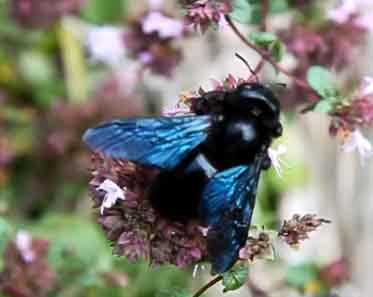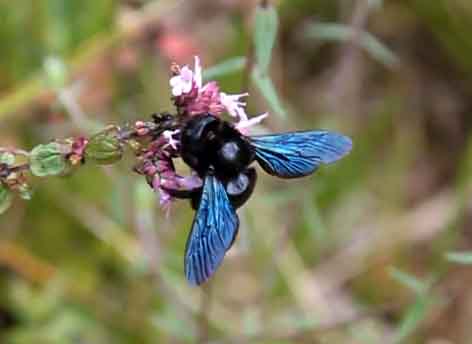Blue Bee
Blue Bee (Orchard Mason Bee)
Scientific Name of the Blue Bee – Osmia lignaria
All about the Blue Bee
The Blue Bee is another name for the Orchard Mason Bee and is also known as the Blueberry Bee, or Blue Orchard Bee. In North America, it is widely used as a pollinator of orchards, hence the name “Orchard” bee.
What does the Blue Bee look like?
Blue bees have a distinctive metallic blue or green color, though some are black. They have black ventral scopae and arolia between their claws. Male Blue Bees (11mm) are normally smaller than the females (14 mm). The actual size of a Blue Bee is determined by the size of the hole out of which it is born, but most Blue Bees are slightly smaller than a honeybee.

Blue Bee
Where does the Blue bee live, and what does it eat?
The Blue Bee is native to the western U.S. but its range now covers southern Canada and most parts of North America. Blue Bees are found mainly in woodlands and forest edges where fruit trees are grown.
Solitary and gregarious creatures, the Blue Bee does not build a beehive with a colony but a nest on its own. Although Blue bees tend to nest individually, several bees may build nests near each other. The “neighbors” of the Blue Bee do not depend on one another, just live in close proximity in nests of their own. The nest of an Blue Bee is built in holes in wood like shake siding or nail holes. The female Blue Bee will gather pollen and make a nest out of it, placing it in a hole only just larger than she is. She will then lay her eggs on the pollen nest and close off the hole with a mud wall. Layers of mud are piled up to block off the hole entirely. The eggs are left there until they hatch and break through the rough mud plug.
Although the Blue Bee does not make honey it does eat pollen, particularly from fruit trees, and is therefore an excellent pollinator. The Blue Bee prefers Ballhead waterleaf, dandelion, Oregon grape, cherries, and apples.
The Blue Bee’s Circle of Life
The female Blue bee only lives for about one month but produces one or two eggs each day. After the female lays her eggs in a cell made with pollen and nectar, the young bees hatch within a few days, eat the provisions provided by the mother bee, then pupate within the cell of the nest. The young bees remain in the cocoon, pupating, through winter. In the spring, when the bees have reached adulthood, they will emerge and begin making nests of their own within three or four days. While the Blue Bee is excellent for pollinating fruit trees, its short life span is one drawback.
Blue Bees and Humans
Both male and female Blue Bees are equipped with stingers, but are non-aggressive bees and will only sting if trapped or roughly handled. In fact, the stinger on the Blue Bee is meant as an egg guide. These bees may become protective of their nests and buzz around close to it, but are not likely to sting.

Blue Bees Pollinate Orchards
The nest of the Blue Bee is not thought to be harmful to structures. These bees do not bore their own holes, but nest inside existing holes and bring in from outside the debris out of which the nest is made. The nest leaves little or no trace and because this bee is a good pollinator, it can actually have some benefits.
Treating the Sting of Blue Bees
Even though the Blue bee rarely stings humans, they have been known to sting if provoked. If you know you are allergic to bee stings or experience symptoms other than localized pain, itching or swelling, seek a medical professional immediately. Stay calm and move indoors. Keep the affected area below the heart at all times and remove any stingers gently with your fingernail, a credit card, or butter knife. If the stinger is still in your skin, the venom sac most likely is too – don’t squeeze the sting or you may release more venom into the sting—ouch! Treat the sting(s) with cold compresses and use an over-the-counter pain medication. If symptoms persist more than a few days, see a doctor.
Symptoms of an allergic reaction to a bee sting include burning and itching, body swelling, body rash, weakness, nausea, difficulty breathing, shock, or unconsciousness. If you believe you have an allergy to bee venom, see a doctor about obtaining an anti-venom first aid kit.
Professional Blue Bee Control
Keep in mind that the Blue bee is an efficient pollinator for gardens. Control of the Blue bee should be employed if structures are at risk or there are secondary problems like the introduction of new pests or an allergy to bee venom.
- Bee Identification: First a professional will positively identify the bee species to make sure they employ the proper measures of getting rid of the hive.
- Insecticide: In the late afternoon or after nightfall (when the bees have returned to their nests), a professional will apply insecticide by spraying into the entrance to the nest. Concentrated dust pesticides containing cypermethrin like Cynoff WP or Demon WP are most commonly used. A dust pesticide is used so that the bee is covered but can still exit the nest during the day. When the bee cleans itself, the insecticide will be ingested and the bee will die. Over spraying the nest could cause the bees to remain inside the nest, leaving dead bees and a mess behind.
- Follow Through! As a follow-up treatment, a liquid insecticide is best. In early spring before Blue bee nesting has occurred, a professional will apply liquid spray to the affected areas to keep the bees from returning to nest.
DIY and Green Solutions for Blue Bee Control
Where bee infestation is not serious or insecticide use is not desired, there are do-it-yourself or green options for getting rid of the Blue bee. Keeping in mind that Blue bees are a most excellent pollinator for vegetable, fruit, and flower gardens, remove beehives only when they are in or on your home or have become a threat to family members. Otherwise the bees can actually be a very welcome part of your garden.
- Homemade repellent: Mix vinegar, oil, and garlic to create a natural repellent for the Blue Bee. Spray around the nest or areas where the Blue Bee has been sighted. If numbers don’t drop dramatically, apply a second coat of the mixture.
- Call a green pest control service. Certain pest control companies specialize in green solutions to your pest problems. Companies that employ green or natural pest control services can eliminate pest problems using natural pesticides and kid/animal-safe products.
- End with Exclusion! Once the nest is empty, clean the nest area thoroughly with soapy water then seal all entrances points with steel wool and caulking. Paint or stain them as necessary.
The Blue bee, or Blue bee, is not a particular threat to humans and is a good pollinator, but if it has become a pest in your garden employ one or more of these control methods.

